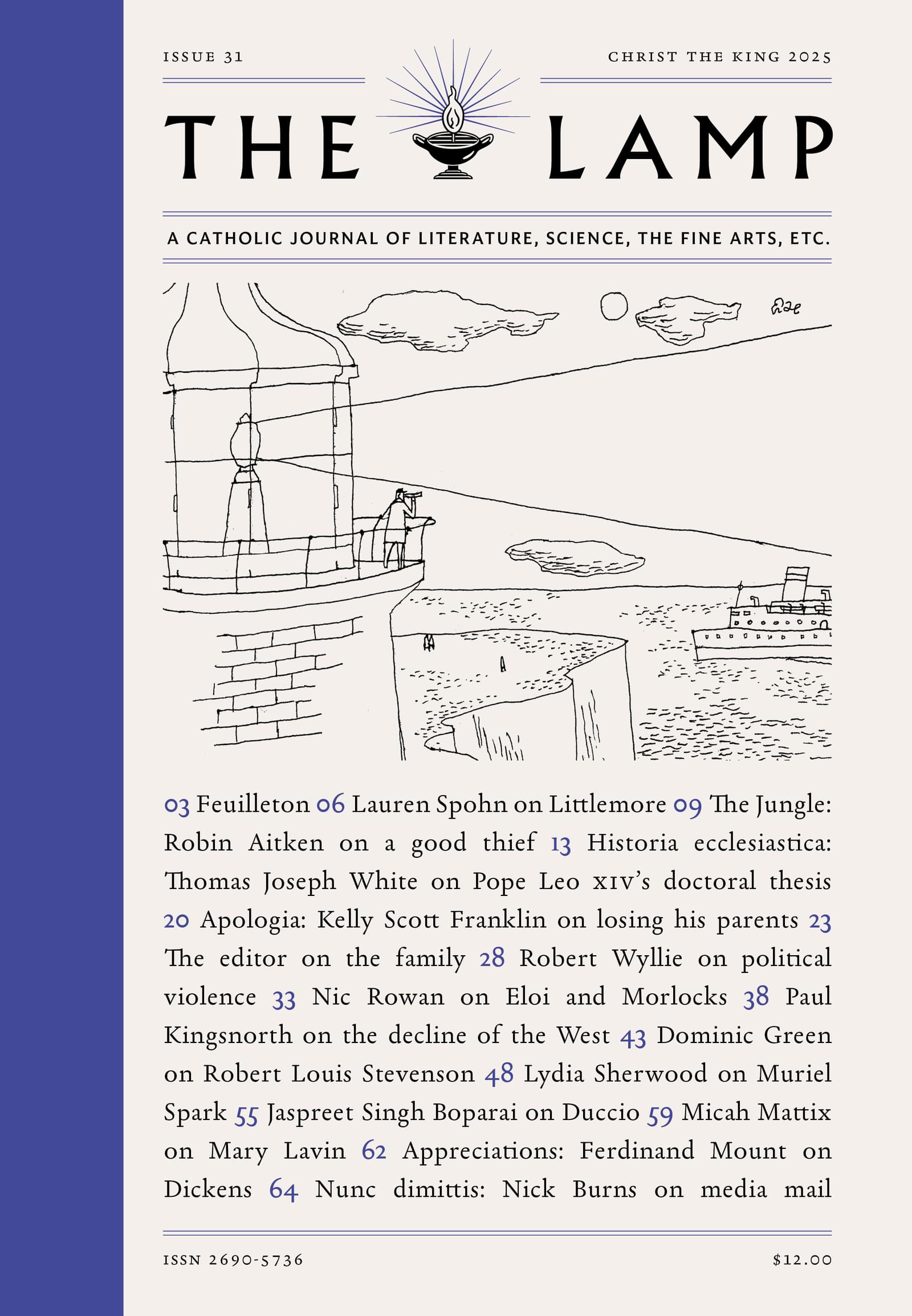Feuilleton
✥ One evening on a long train ride home from Edinburgh, I passed a room in a sleeping carriage where a gaggle of children were being tucked in by their nanny. I paused just outside the entryway to observe the commotion. Presently the nanny began their evening prayers, beginning with this:
We pray for gramma, and grampa too,
We pray for sister and her boo-boo.
We pray for people at the store,
We pray as well for those who snore.
We pray for Aunt Jackie and Uncle Josh,
And all the animals, by gosh,
For all in Bonn or Bangalore:
Particularly, those who snore.
We pray for Mom, we pray for Dad.
We pray for people who are bad,
That they may turn back to the Lord
(Especially the ones who snore).
We pray for those whose ends were gory
And all the people in Purgatory.
We pray for him who sleeps outdoors,
And through the dark cold twilight snores.
So let us pray the Lord this night
To keep us safe ’til morning light.
May He grant mercy all the more
To those who loudly, loudly snore.
—Jake Neu
✥ It is Good Friday. A hushed silence falls over the crowd of spectators as the leader of the penitents, the regidor, rings an iron bell to warn of the coming procession. The sound of the bell accompanies a mournful tambourine beating a slow cadence to the steps of the participants solemnly walking into the square in front of Saint John the Baptist Cathedral in Perpignan, France. On the shoulders of the penitents lies a life-size statue, a misteri, in the language of Catalonia, of a crucified Jesus, heavy on the shoulders of the men, carrying the weight of as many as one hundred kilograms as penance. Some of the men are barefoot. Others carry misteris of Mary, mourning the suffering and death of her Son. Women dressed in black, both young and old, do the same. This is la Sanch, the blood, a procession commemorating the Passion and Agony of Christ, that takes place in the town each year.
Visitors who are unfamiliar with la Sanch might feel bewildered when seeing the participants’ black and red tunics and pointed headpieces. But for six centuries, la Sanch has been part of the culture of Perpignan, as well as other towns in French Catalonia, and it attracts thousands of spectators each year. The Brotherhood of La Sanch was founded in 1416 by Saint Vincent Ferrer after he nearly died of a fever in 1398 but was miraculously cured by an apparition of Christ accompanied by Saints Dominic and Francis.
These days, la Sanch is more than just a procession. It is also a way of preserving a Catalan religious and historic ritual. For the approximately seven hundred participants in la Sanch, this procession is a way of atoning for sins committed over the past liturgical year. And for all watching, it can also be a time for piety and devotion. The leaders’ red tunics and pointed headpieces, Caperutxa in Catalan, shining brilliantly in the Perpignan sun, symbolize blood. Those who follow wear black tunics and Caperutxa symbolizing death; only priests and children wear white, symbolizing the innocents and the saved. The Caperutxa worn by each man hides his identity and reveals only his eyes. The practice dates from the fifteenth century, when Dominican monks led condemned men to their executions and hid their identities to prevent them from being beaten on the way. Protecting the accused from retribution also assured them of a religious burial.
Silence reigns among the participants of la Sanch in Perpignan on Holy Saturday, but the ringing of the bells of the Cathedral of Saint John can be heard throughout the city as the celebration of Easter Sunday begins. Priests and acolytes process down the nave of the cathedral, hymns are sung, and incense burns, creating an otherworldly, joyful atmosphere, so different from that of Friday’s solemnity.
—Ava Kobouchy
✥ From my chambers in the county courthouse, I can hear the bells of my parish church. The tinny Runic rhyme wells outside my window, between the courthouse and the jail, across to City Hall and the crooked lines of tent villages beside the park. If one is quiet, they are even discernible at the bottom of the hill, in the business district.
They are merry bells for weddings, and somber bells for funerals, and irksome bells that remind me that there is a holy day that I forgot. (In truth, the bells are all the same, but their context matters.) When a church bell rings across a town, it lays some claim to it, like a sprinkling of holy water from an aspergillum. Such a claim can be literal: A Cockney, for example, is anyone living within the sound of the bells of Saint Mary-e-Bow in London’s Cheapside. The sound of the bell marks its audience, whoever it might be.
And therein lies the tension of a church bell—an expression of faith for the bell ringer but also an imposition of that faith on everyone else. The distinction might not matter much to most of us, but for those who think carefully about the matter—particularly those who see danger in religion—the distinction is glaring. It is why the French Revolutionaries banned the church bell. So did the Mexican Revolutionaries of 1910. And the Spanish Republicans of 1931.
The American answer has always been to protect the bell. The First Amendment may prohibit the establishment of religion, but in protecting the free expression of religion, it means that the public square might be awash in the clinging of bells and—along with them—calls to prayer. The resulting cacophony might lack the dry order of a laicized French boulevard, but it has a certain energy all its own, some hidden ingredient in America’s successes. It is at least a roadblock to our worse inclinations.
My parish church was built in 1901, an imposing neo-Romanesque church with four spires and a lot of stone, as grand and bold as the National Guard armory one block away. A primary school followed a decade later. The Irish American worshippers who looked upon these mighty works—transposed so inelegantly from European designs onto Salishan soil—could rightly claim to have arrived. But, vanitas vanitatum, the feeling was short-lived. In 1919, the church burned down, and the parish had no choice but to move its worship into the church basement.
In time, the parish settled permanently into the basement, which now contains all the trappings of a proper church. It built a new roof of local timber, which allows a flow of air and light into the sanctuary. Saints that did not appear in the old church—Our Lady of Guadalupe, Kateri Tekakwitha, and Lorenzo Ruiz—now have pride of place in the new one. On the steep-sloped streets that are typical on the Puget Sound, the basement fits, tucked into the hill as if it belongs there.
The other great building—the parish school—closed a half-century later, in the 1970s. Its immigrant students had long since assimilated into the middle-class suburbs. This new generation moved away from its old parish church and the urban core of the city, much like the downtown department stores that fled in the same decade. The parish has repurposed the school building as the center for Catholic Community Services. It serves the tent villages nearby.
The parish has long since abandoned any plans to rebuild. The memory of the old church building only exists in the history page of the parish website. In truth, the old spires so much in vogue at the turn of the last century are now well out of date. But the parish did not stand still. There was one part of the old church that they did rebuild, and it was the only part. It was the bell tower. Its bell resumes its rhythm, casting its blessings on believers and unbelievers alike.
—André M. Peñalver
✥ We would like to remind all of our readers that seminarians and those living in vowed religious poverty are eligible to receive complimentary subscriptions. If you or someone you know falls into one of these two categories and would like to receive the magazine, please let us know at subscriptions@thelampmagazine.com. Many thanks to those of you who subscribe at the more expensive “Solidarity” rate for making it possible for us to offer gratis subscriptions. When you sign up for the extra sixty dollars, you are quite literally buying a second subscription for a worthy person who cannot afford one.
✥ While we are on the subject of free copies, we should add that we are always looking to expand our readership on college campuses as well. If you are a student looking to spread the word, email us at the address mentioned above. Maybe we can send you a box of issues.
✥ Finally, we would like to welcome Mary Kate Rogers to the The Lamp. Longtime readers are likely already familiar with the essays she has written for us since almost the very beginning (under her maiden name, Skehan). In her new role she will continue to write but focus primarily on marketing as the magazine continues to grow.




